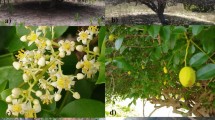Abstract
Polymerase Chain Reaction (PCR) and subsequent separation of PCR products on polyacrylamide gels to find Single Stranded Conformation Polymorphisms (SSCP) was used for three loci, known from studies in North America to affect defensive behavior (Quantitative Trait Loci (QTL) sting1–3), on samples of Iranian honey bee (Apis mellifera L.). In the present study these loci were amplified with specific primers for sting1–3. The analysis of these loci using SSCP, created different patterns among samples. The polymorphisms observed in this study of the Iranian population of honey bees are a first step toward the eventual implementation of a genetic marker-based selection program to reduce defensive behavior. Now, because of this study, the markers are available to conduct more research so that the association of these polymorphic loci and aggressive traits in the Iranian honey bee population can be determined.







Similar content being viewed by others
References
Arechavaleta-Velasco ME, Hunt GJ, Emore C (2003) Quantitative trait loci that influence the expression of guarding and stinging behaviors of individual honeybees. Behav Genet 33:357–364
Arechavaleta-Velasco ME, Hunt GJ (2004) Binary trait loci that influence honey bee (Hymenoptera: Apidae) guarding behavior. Ann Entomol Soc Am 97:177–183
Breed MD, Guzman-Novoa E, Hunt GJ (2004) Defensive behavior of honeybees: organization, genetics and comparisons with other bees. Annu Rev Entomol 49:271–298
Breed MD, Rogers KB (1991) The behavioral genetics of colony defense in honeybees: genetic variability for guarding behavior. Behav Genet 21:295–303
Breed MD, Smith TA, Torres A (1992) Role of guard honey bees (Hymenoptera, Apidae) in nestmate discrimination and replacement of removed guards. Ann Entomol Soc Am 85:633–637
Collins AM, Kubasek KJ (1982) Field test of honey bee (Hymenoptera: Apidae) defensive behavior. Ann Entomol Soc Am 75:383–387
Collins AM, Rinderer TE, Harbo JR, Bolten AB (1982) Colony defense by africanized and European honey bees. Science 218:72–74
Collins AM, Rinderer TE, Harbo JR, Brown MA (1984) Heritabilities and correlations for several characters in the honeybee. J Hered 75:135–140
Connor L (2006) Drone saturation. For small scale operations. Bee Cult 32:35
Guzman-Novoa E, Page RE (1993) Backcrossing Africanized honeybee queens to European drones reduces colony defensive behavior. Ann Entomol Soc Am 86:352–355
Guzman-Novoa E, Page RE (1994a) Genetic dominance and worker interactions affects honeybee colony defense. Behav Ecol 5:91–97
Guzman-Novoa E, Page RE (1994b) The impact of Africanized bees on Mexican beekeeping. Am Bee J 134:101–106
Guzman-Novoa E, Page RE, Spangler HG, Erickson EH (1999) A comparition of two assayes to test the defensive behaviour of honey bees (Apis mellifera). J Apicult Res 38:205–209
Guzman-Novoa E, Hunt GJ, Uribe JL, Smith C, Arechavaleta-Velasco ME (2002) Confirmation of QTL effects and evidence of genetic dominance of honeybee defensive behavior: results of colony and individual behavioral assays. Behav Genet 32:95–102
Guzman-Novoa E, Hunt GJ, Page RE, Uribe-Rubio JL Jr, Becerra-Guzman D (2005) Paternal effects on the defensive behavior of honeybees. J Hered 96:376–380
Hall TE (1999) BioEdit: a user-friendly biological sequence alignment editor and analysis program for Windows 95/98/NT. Nucleotide Acids Symp Ser 41:95–98
Hayashi K (1991) PCR-SSCP: a simple and sensitive method for detection of mutations in the genomic DNA. Genome Res 34:38
Hunt GJ, Page RE (1995) Linkage map of honey bee, Apis mellifera based on RAPD markers. Genetics 139:1371–1382
Hunt GJ (1997) Insect DNA extraction protocol. In: Micheli, Bova R (eds) Fingerprintng methods based on arbitrary primed PCR. Springer-Verlag, Berlin, pp 21–24
Hunt GJ, Guzman-Novoa E, Fondrk MK, Page RE (1998) Quantitative trait loci for honeybee stinging behavior and body size. Genetics 148:1203–1213
Lobo NF, Ton LQ, Hill CA, Emore C, Romero-Severson J, Hunt GJ, Collins FH (2003) Genomic analysis in the sting-2 quantitative trait locus for defensive behavior in the honey bee, Apis mellifera. Genome Res 13:2588–2593
Moore AJ, Breed MD, Moor MJ (1987) The guard bee: ontogeny and behavioral variability of worker performing a specialized task. Anim Behav 35:1159–1167
Oldroyd BP, Thompson GJ (2007) Behavioral genetics of the honey bee Apis mellifera. Adv Insect Physiol 33:1–49
Page RE, Fondrk MK, Hunt GJ, Guzman-Novoa E, Humphries MA, Nguyen K, Greene A (2000) Genetic dissection of honeybee (Apis mellifera L.) foraging behaviour. J Hered 91:474–479
Spivak M, Rueter GS (1998) Honey bee hygienic behaviour. Am Bee J 138:183–286
Stort AC (1974) Genetic study of the aggressiveness of two subspecies of Apis mellifera in Brazil. I. Some tests to measure aggressiveness. J Apic Res 13:33–38
Acknowledgments
Special thanks must be given to Dr. Hossein Moradi Shahrebabak for his invaluable guides during this study.
Author information
Authors and Affiliations
Corresponding author
Rights and permissions
About this article
Cite this article
Safdari Shahroudi, M., Mehrabani-Yeganeh, H., Pakdel, A. et al. A Study of Polymorphisms in Three Loci Known to Influence Defensive Behavior Using PCR-SSCP and Direct Sequencing in the Iranian Honey Bee Population. J Insect Behav 27, 133–143 (2014). https://doi.org/10.1007/s10905-013-9417-1
Revised:
Accepted:
Published:
Issue Date:
DOI: https://doi.org/10.1007/s10905-013-9417-1




